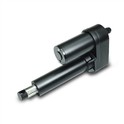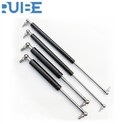The lifespan of a gas damper is a crucial consideration for both consumers and suppliers. As a gas damper supplier, I've encountered numerous inquiries about how long these components can effectively serve their purpose. In this blog, I'll delve into the factors that influence the lifespan of a gas damper, typical lifespan ranges, and ways to extend their usability.
Factors Affecting the Lifespan of Gas Dampers
1. Quality of Materials
The materials used in manufacturing gas dampers play a pivotal role in determining their lifespan. High - quality seals, pistons, and cylinders are essential. For instance, dampers with seals made from premium rubber compounds are more resistant to wear, tear, and degradation caused by environmental factors such as temperature and humidity. A well - crafted piston ensures smooth movement within the cylinder, reducing friction and preventing premature failure. As a supplier, we source the best materials to ensure our gas dampers have a longer service life. Our [Cabinet Gas Damper](/gas - damper/cabinet - gas - damper.html) is built with high - grade materials, which significantly enhances its durability.
2. Frequency of Use
The more frequently a gas damper is used, the shorter its lifespan is likely to be. In applications where the damper is opened and closed multiple times a day, such as in a busy commercial kitchen cabinet, the internal components experience more stress and wear. On the other hand, a gas damper in a rarely - used storage cabinet may last much longer. For example, our [Gas Damper for Car](/gas - damper/gas - damper - for - car.html) in a daily - driven vehicle will face more usage compared to one in a classic car that is only driven on special occasions.

3. Environmental Conditions
Environmental factors can have a substantial impact on the lifespan of gas dampers. Extreme temperatures can cause the gas inside the damper to expand or contract, affecting its performance. High humidity can lead to corrosion of metal parts, while exposure to chemicals or abrasive substances can damage the seals and other components. In industrial settings, where there may be exposure to harsh chemicals, gas dampers need to be more robustly constructed to withstand these conditions.
4. Installation and Maintenance
Proper installation is crucial for the optimal performance and lifespan of gas dampers. Incorrect installation can lead to misalignment, increased friction, and uneven stress on the components, which can significantly shorten the damper's life. Regular maintenance, such as cleaning and lubrication, can also extend the lifespan of a gas damper. However, over - lubrication can attract dust and debris, which may cause damage.

Typical Lifespan Ranges
The lifespan of a gas damper can vary widely depending on the factors mentioned above. In general, a well - made gas damper used in normal household applications, such as cabinet doors, can last anywhere from 5 to 10 years. For more heavy - duty applications, like in automotive or industrial settings, the lifespan may range from 3 to 7 years. However, these are just rough estimates, and in some cases, with ideal conditions and proper maintenance, gas dampers can last even longer.
Ways to Extend the Lifespan of Gas Dampers
1. Choose the Right Damper
Selecting a gas damper that is appropriate for the specific application is essential. Consider factors such as the weight of the object being dampened, the frequency of use, and the environmental conditions. As a supplier, we offer a wide range of gas dampers, and our team can help customers choose the most suitable product for their needs.

2. Follow Installation Guidelines
Always follow the manufacturer's installation instructions carefully. If you're unsure, it's advisable to seek professional help. Proper installation ensures that the gas damper functions correctly from the start, reducing the risk of premature failure.
3. Regular Inspection and Maintenance
Periodically inspect the gas damper for signs of wear, such as leaks, corrosion, or damage to the seals. If any issues are detected, address them promptly. Cleaning the damper regularly and applying a small amount of appropriate lubricant can also help keep it in good working condition.

4. Protect from Harsh Environments
If possible, protect the gas damper from extreme temperatures, humidity, and exposure to chemicals. In industrial settings, consider using protective covers or enclosures to shield the damper from harmful substances.
Conclusion
Understanding the lifespan of a gas damper and the factors that influence it is crucial for both consumers and suppliers. As a gas damper supplier, we are committed to providing high - quality products that offer long - lasting performance. By choosing the right damper, following proper installation and maintenance procedures, and protecting it from harsh environments, customers can maximize the lifespan of their gas dampers.
If you're in the market for gas dampers and are looking for reliable products, we'd love to hear from you. Whether you need a [Cabinet Gas Damper](/gas - damper/cabinet - gas - damper.html) for your home or a [Gas Damper for Car](/gas - damper/gas - damper - for - car.html) for your automotive application, we have the expertise and the products to meet your needs. Contact us today to start a conversation about your gas damper requirements and explore how we can assist you in finding the perfect solution.
References
- Engineering Materials Handbook, ASM International
- Automotive Suspension and Chassis Design Manual, SAE International






